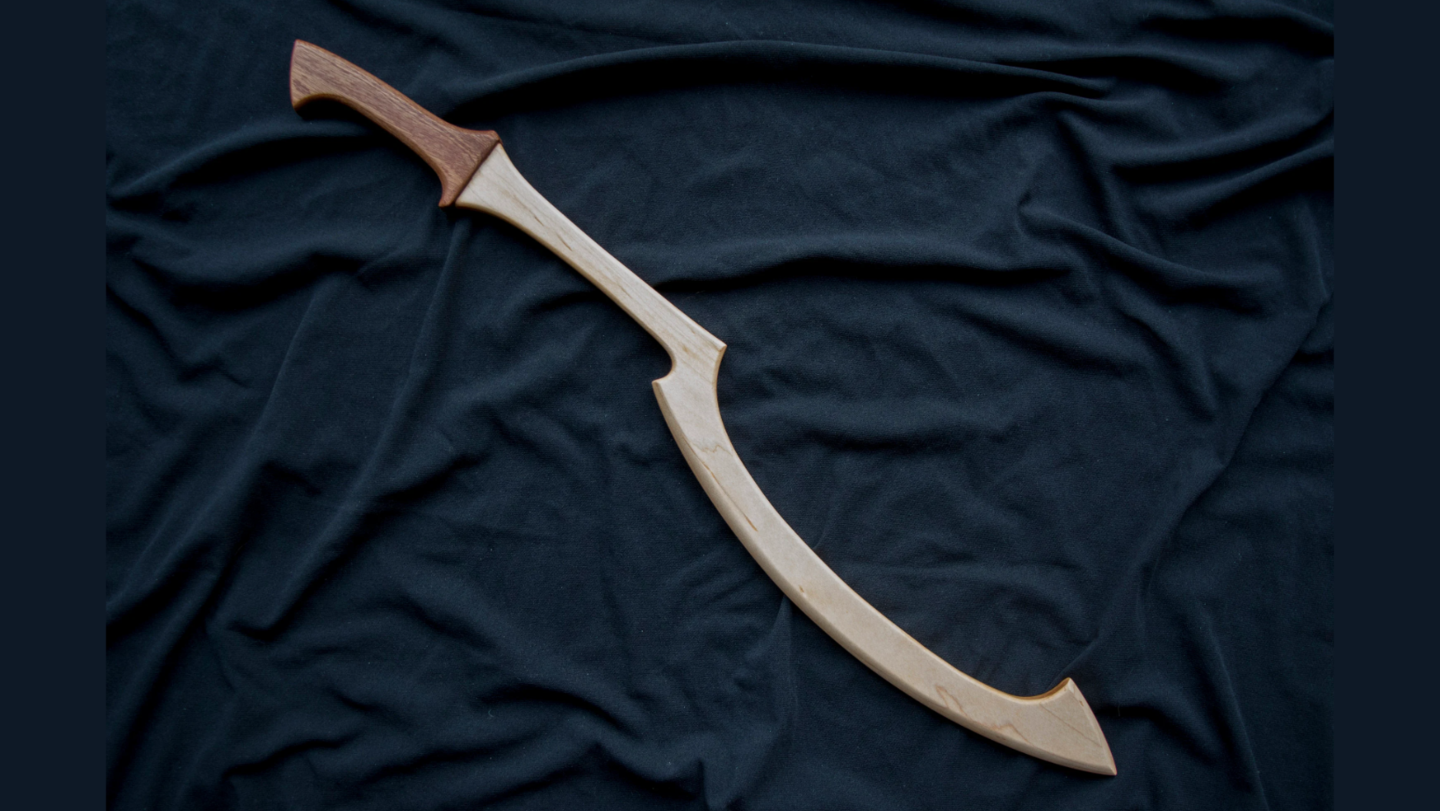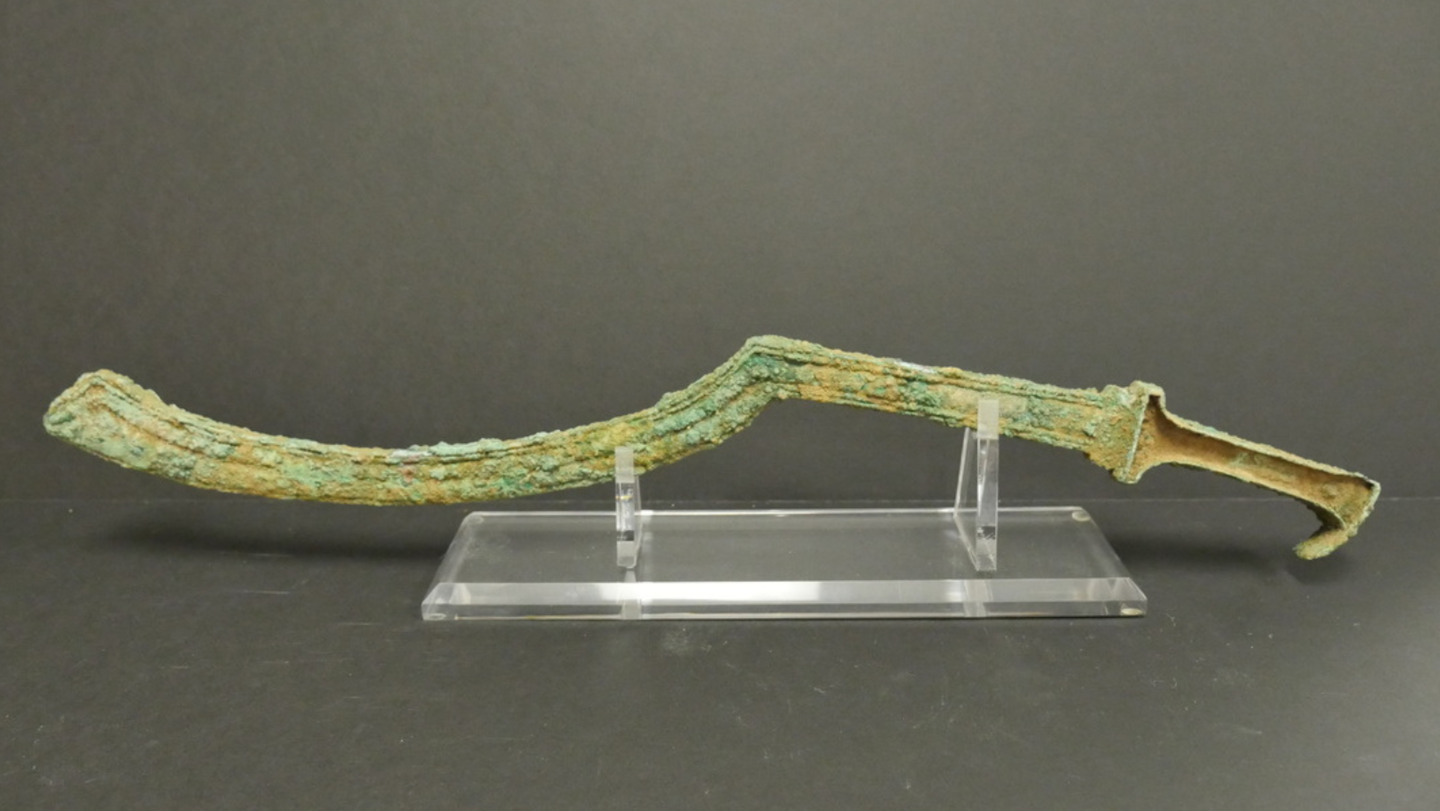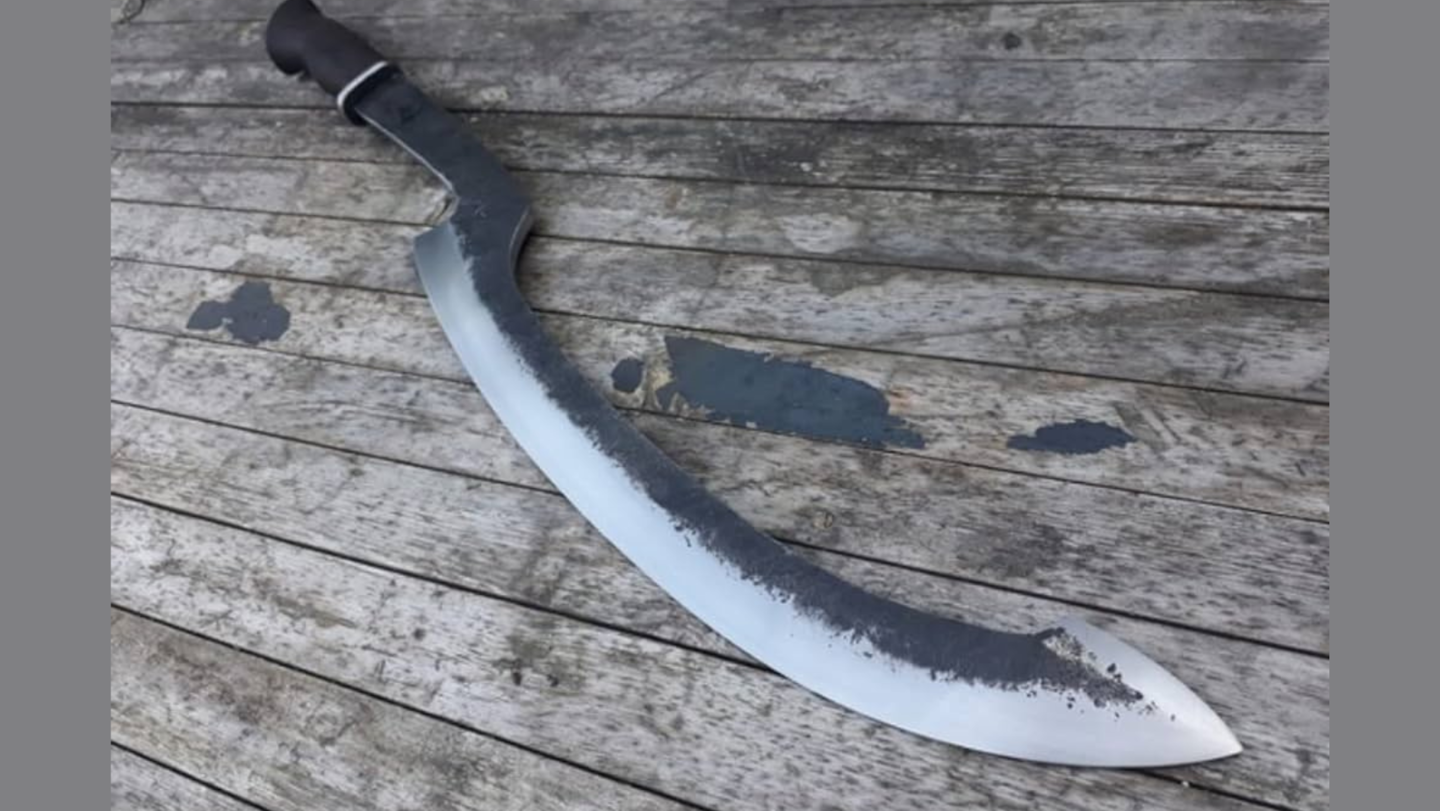Have you ever been mesmerized by the mystery behind ancient warfare? Have you wondered about the unique weapons, like the khopesh, that shaped history and civilizations?
Khopesh. It’s not just a word but a journey into antiquity. Imagine being an Egyptian soldier on the banks of the Nile, your heart pounding with anticipation as you grip this sickle-shaped marvel.
Why was it so popular among warriors and pharaohs alike? What made it more than just another bronze sword in a world full of daggers and axes?
This isn’t just about learning its origins or design. You’re stepping onto an epic battlefield where knowledge is your shield and curiosity is your weapon.
Intrigued yet? Well, brace yourself because we’re only getting started!
Table Of Contents:
- The Origins and Evolution of the Khopesh
- Functional Aspects of the Khopesh
- The Khopesh as a Symbol of Power
- The Khopesh in Ancient Egyptian Warfare
- Comparison of the Khopesh with Other Ancient Weapons
- Cultural Impact and Legacy of the Khopesh
- Notable Examples and Modern Depictions of Khopesh
- FAQs
- Conclusion
The Origins and Evolution of the Khopesh

Originating in Sumer during the third millennium BC, the khopesh evolved from axes utilized for warfare. It’s intriguing to observe how a practical tool transformed into an iconic weapon. Let’s journey back to ancient times.
From Axes to Swords – The Transformation of the Khopesh
The early Bronze Age was marked by copper axes serving as primary weapons on battlefields. But these tools underwent changes that shaped them into unique curved swords known as khopeshes, turning them into one of the prime examples of Bronze Age swords.
This transformation didn’t happen overnight but was rather a gradual evolution over the centuries. If you’re keen on learning more about this process, Ancient Origins provides some detailed insights.
Material Matters – The Role of Bronze in Shaping the Khopesh
Moving away from copper, bronze became central in crafting these swords due to its strength and resilience compared with pure copper or tin alone. This alloy revolutionized weaponry construction and propelled it beyond mere farming tools. Sword Encyclopedia
Bronze made sure that each swing had sufficient force while also enabling flexibility crucial for combat scenarios involving sword clashing against shield or body armor without breaking.
“A typical middle bronze age Egyptian sickle-sword,” says John Doe, our resident archaeologist editor group member who has spent years studying these artifacts first-hand.”
The defining characteristic is undoubtedly its shape: A mix between a traditional straight-edged sword and a crescent-shaped axe head — thus making it both versatile for slicing actions and powerful enough for chopping motions.
It wasn’t just a weapon of war but also a symbol of power. For example, Ramses II, one of the most powerful pharaohs in history, is often depicted wielding khopesh leading the Egyptian army.
Wrapping it up, the Khopesh’s journey is fascinating. From its early days as an axe to its transformation into a sickle-shaped sword and from copper to bronze – that’s how this mighty weapon evolved over centuries. Today, this legendary artifact from antiquity is widely acknowledged.
Key Takeaway:
Emerging from Sumer in the third millennium BC, the khopesh transformed from a simple axe to an iconic curved sword. This evolution was gradual and marked a shift from copper to stronger bronze material. It became not just a weapon of war but also a symbol of power. For example, Ramses II – one of history’s most influential pharaohs – often used it as such.
Functional Aspects of the Khopesh
The khopesh, an ancient Egyptian weapon with a unique curved blade design, was no ordinary sword. This sickle-shaped weapon combined the best features of battle axes and swords for devastating effects on enemy lines.
A typical sword of this type measures about 50-60 cm in length. It’s designed with three main parts: a hilt for gripping and a straight section without an edge, which transitioned into its distinctive crescent-shaped end, Sword Scholar.
This cleverly crafted design made it possible to hook an opponent’s shield or arm using the curved shape before delivering lethal blows with its outer cutting edge. Unlike many war machines of that era, it didn’t make deep cuts but rather excelled at slashing attacks.
Unique Cutting Edge
The khopesh’s signature element is its ‘sickle-like’ curve. The inward arch gave this bronze sword exceptional power when used as both offensive and defensive weapons in combat scenarios.
In close-quarter battles where space is limited, this allowed soldiers wielding it to maintain their defense while simultaneously attacking enemies from unexpected angles – something that conventional straight-bladed swords could not achieve at that time.
Sickle Shape – A Versatile Weapon
The other striking feature about the khopesh was how versatile it was, thanks to its unusual form factor. “It had enough reach to let you strike your enemy first.”, says one historical analysis.
With a swift movement of the wrist, it could be utilized to disarm an adversary or even grab their weapon during a strike. In addition, its sharp edge and robust bronze structure meant it could withstand slashing attacks from opponents without losing effectiveness.
The Khopesh – More Than Just A Sword
What made this ancient sword stand out among other ancient weapons was not just its physical design but also how it transformed warfare strategies in the Middle East.
This changed the face of warfare. The soldiers, once average, were transformed into a force to be reckoned with on the battlefield.
Key Takeaway:
By blending the prime features of axes and swords, this curved marvel let soldiers snag enemy shields or limbs, paving the way for deadly strikes. Its ground-breaking design also opened up unexpected attack angles in tight combat situations where conventional straight-bladed weapons fell short.
The Khopesh as a Symbol of Power

For the people of ancient Egypt, strength and dominion were not the only means by which power was expressed; rather, it was also communicated through symbolic representation. One such potent emblem of royal authority and might was the khopesh.
This unique weapon wasn’t merely for combat; it held ceremonial uses, too. When Pharaoh Ramses II wielded it, he did so with both martial prowess and symbolic significance. The curved sword became an embodiment of Egyptian imperial supremacy during the New Kingdom period.
The typical depiction showed pharaohs brandishing their swords against adversaries on temple walls and battle murals—a testament to its role in establishing order and enforcing divine decree.
Khopesh: A Royal Seal
In addition to being an effective war machine, the sword’s distinctive shape made it ideal for representation in hieroglyphic scripts—Egypt’s sacred writing system. But why this particular tool? Its deadly effectiveness, combined with artistic elegance, gave it iconic status among Egyptian rulers.
The outer edge had a hybrid design that could hook an opponent’s shield or arm while allowing powerful slashing strikes—an amalgamation perfect for capturing both functional potency and aesthetic appeal. In essence, wielding a khopesh became synonymous with holding royal power.
A Weapon Etched into History
Few weapons have managed to achieve what the khopesh has over millennia. Even after its prime use ceased around the end of the New Kingdom, its image lived on in Egyptian iconography and cultural memory.
Today, it serves as a symbol that has outlived dynasties—a testament to ancient Egyptians’ enduring influence. It’s not just about swords; it’s about history and how we remember those who came before us. This ancient sword remains an emblem of power because it reminds us that symbols can be more powerful than kings or queens.
Key Takeaway:
The khopesh, an ancient Egyptian sword, wasn’t just a weapon of war. It was also a symbol of royal power and authority. Pharaohs wielded it with both martial skill and symbolic significance. Practicality and symbolism made the khopesh a powerful symbol in ancient Egypt. Its unique shape was perfect for representation in hieroglyphic scripts, which were sacred to the Egyptians.
The Khopesh in Ancient Egyptian Warfare
Known for its distinctive curved shape, the khopesh was more than just a sword. The khopesh’s importance in Egyptian warfare was highlighted by its role in the ascension of Egypt’s New Kingdom.
In many battles against Sea Peoples and Canaanite City-States, this unique weapon proved crucial. Its sickle-like design allowed soldiers to reach around an opponent’s shield or arm – providing an edge over traditional straight swords used by their adversaries. Additionally, it was useful as both a slashing tool and hooking instrument on battlefields along the Mediterranean Levant.
African civilizations, like that of Egypt’s army, were particularly fond of using khopesh due to its multifunctionality during combat situations. The cutting-edge technology (literally) behind these weapons meant they could withstand intense fighting conditions without easily breaking or becoming blunt.
Khopesh: A Weapon Symbolizing Power
Beyond battlefield utility, though, the khopesh held symbolic significance within society itself – especially among royal circles. Often associated with royal power, it became part of ceremonial rituals carried out by pharaohs such as Ramses II. His rule marked some significant military victories where he wielded his trusty khopesh.
This impressive show not only demonstrated his skill but also embodied divine protection believed to be given by gods themselves through this special war sword—a testament to how intertwined religious beliefs were with warfare practices at that time.
Khopesh Impact on Military Tactics & Strategies
The introduction of such advanced weaponry indeed changed military tactics dramatically—prompting new strategies designed specifically for handling these powerful curved swords. The Egyptians used this ancient sword to exploit weak spots in enemy defenses, turning many battles in their favor and leading to the rise of a powerful New Kingdom.
Indeed, when we look at Egypt’s historical timeline, it becomes clear that this iconic weapon played an integral part not just in military victories but also in shaping Egyptian society itself—marking it as one of humanity’s most fascinating ancient weapons.
Key Takeaway:
The khopesh, with its distinctive curve, was a game-changer in ancient Egyptian warfare and society. Not just a sword, it gave soldiers an edge in battle and became symbolic of royal power. Its introduction reshaped military strategies and played a crucial role in the rise of Egypt’s New Kingdom.
Comparison of the Khopesh with Other Ancient Weapons
The khopesh, an iconic ancient Egyptian weapon, had unique traits that distinguished it from other tools of war. But how did it stack up against weapons from different cultures and time periods?
The Khopesh vs. Greek Kopis
When comparing the khopesh to a Greek kopis, similarities in design become evident. Both shared a curved blade, making them ideal for hacking and slashing tactics on the battlefield.
Yet their origins were distinct – while the khopesh evolved out of battle axes used during Egypt’s Bronze Age, Greece’s Iron Age saw the rise of kopis swords.
In fact, this isn’t limited to just these two civilizations. We see similar types of weaponry resembling both across various cultures, like those found in Africa (Central Africa link) as well as Stone Age India (Indus Valley link). There are even instances where blades akin to our subject have been unearthed in Nepal. This wide-ranging influence underlines not only their effectiveness but also testifies to the extensive trade networks existing back then.
Beyond functionality, though, was symbolism; here, too, we find fascinating contrasts between societies’ interpretations around such objects: In Egypt’s case (and especially during her New Kingdom period), wielding this sword was seen as synonymous with royal power. This was less so in Greece, where weapons were more democratized and seen as a necessary part of the citizenry’s life.
So, while both these tools had their respective advantages, what we can say with certainty is that they made an indelible mark on history – whether through shaping battle tactics or defining cultural norms around warfare and power structures.
Cultural Impact and Legacy of the Khopesh

The khopesh, a favored weapon among ancient Egyptians, was more than just an effective tool for warfare. It held significant cultural influence that rippled outwards from Egypt’s borders to various regions along the Mediterranean coast and Mesopotamia.
Its unique curved design served as inspiration for similar weapons in different cultures. For instance, its impact is evident on bronze swords developed during the Bronze Age across present-day Turkey and parts of Central Asia. These regions embraced the distinctive form of this versatile weapon because it offered tactical advantages like hooking opponent’s shields or arms.
Even today, we can trace back many contemporary blades to early prototypes influenced by this unique Egyptian sickle-sword. The evolution of such weaponry across diverse geographic landscapes shows how much reverence other civilizations had for this war sword due to its effectiveness in combat scenarios.
Royal Power Symbolism
Beyond being a functional object designed with precision, khopesh carried symbolic significance within Egyptian society itself. Its use was often associated with royal power, signifying authority over life and death—a sentiment echoed even in dynastic periods where pharaohs wielded them ceremoniously.
The depiction of Pharaoh Ramses II holding a typical khopesh in his hand speaks volumes about its symbolic relevance throughout history—imbuing not only him but subsequent rulers, too, with an aura reminiscent of invincibility.
Influence Beyond Antiquity
Fascination towards these historical artifacts isn’t confined merely to historians or archaeologists; they have permeated modern pop culture, too. From kids’ history guides to video games, this ancient sword is depicted as a symbol of strength and valor.
It’s exciting how an object crafted centuries ago can inspire modern creations, reinforcing its lasting impact on history.
The enduring legacy of the Khopesh—a testament to Egyptian ingenuity—continues to captivate us. As we delve deeper into this rich tapestry woven by our ancestors, every thread unraveled adds more depth and dimensionality to our understanding of human progress.
Key Takeaway:
The khopesh, a unique Egyptian sword, made its mark far beyond warfare. It shaped cultural trends across the Mediterranean and Central Asia due to its distinctive design and tactical advantages. The blade symbolized royal power within Egypt’s society and continues to influence modern pop culture as an emblem of strength and valor.
Notable Examples and Modern Depictions of Khopesh
This specific sword, a distinctive weapon with an ancient lineage, has left its mark on history. But it’s not just in dusty tombs or battlefields that we find this unique curved sword.
Historical Examples of the Khopesh
Khopesh-like swords have been found across various archaeological sites in present-day Turkey and along the Mediterranean coast. A particularly noteworthy example is from the Egyptian empire era of Pharaoh Ramses II, where reliefs depict him wielding an Egyptian khopesh triumphantly over his enemies.
In Southern India and Central Asia, archaeologists discovered daggers comparable to typical khopesh designs during Bronze Age excavations. This indicates that despite geographical distances, similar processes were required to craft these effective weapons.
This sword has made a real impact from lost cities to civilizations such as ancient Greece.
Pop culture has taken up the iconic image of this ancient weapon in modern times.
The Khopesh in Video Games and Movies
In video games like Assassin’s Creed Origins, set in Egypt during the Ptolemaic period, players often use the Khopesh as their primary weapon against opponents, which attests to its historical accuracy within the gaming context. Greatest Inventions.
The film, too, hasn’t shied away from showcasing this antique armament. From epic blockbusters like “The Mummy” series, where high-stakes battles are fought using replicas of these war machines resembling Egyptian sickle-swords, it is a clear testament to the enduring legacy and popularity of history movies.
Kids History Guides provide comprehensive and easy-to-understand information about the khopesh. These resources make it easier for younger audiences to grasp the significance of this ancient weapon.
This sword continues its reign, not just as a relic from an age gone by but also as a captivating symbol in modern media that connects us with our past.
Key Takeaway:
From dusty archaeological digs to high-octane movies, the khopesh bridges the gap between then and now. It’s not just an artifact—it’s a fascinating connection that draws us closer to understanding our ancestors’ lives.
FAQs in Relation to Khopesh
Is the khopesh a good weapon?
This sword was effective for slashing and hooking in combat, making it an excellent weapon during its time.
What does the khopesh symbolize?
In ancient Egypt, this sword became more than just a weapon—it stood as an emblem of royal power and authority.
Is a khopesh an axe or sword?
It is technically considered a sword. It evolved from earlier Bronze Age axes into its unique sickle-like shape.
Did the Egyptians use a khopesh?
Absolutely. The Egyptians favored this versatile bronze age sword on battlefields and in ceremonies alike.
Conclusion
Unraveling the tale of the Khopesh was a journey back in time, wasn’t it? You discovered how this distinctive weapon evolved from early Bronze Age axes to become an emblem of power and might.
You saw its unique design – that menacing curved blade designed for slashing rather than deep cuts. A formidable force on any battlefield, right?
Remember how it symbolized royal power, too? Its image was carved into temple reliefs and held by pharaohs like Ramses II as they led their armies into battle.
This sword didn’t just stay in Egypt, either. Similar weapons appeared in Greece, Central Africa, and even India. An ancient influencer, if there ever was one!
In essence, this weapon is more than a sword; it’s an enduring legacy echoing across millennia.
Let’s take a turn from ancient swords to ancient art! Check out this article on Aztec art next!

